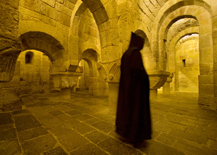
Locality: YESA (31410)
Address: Monasterio de San Salvador de Leyre
Zone: The Central Zone
Website: www.monasteriodeleyre.com
Style: Romanesque
Centuries of construction: IX
Telephones: 948884150 – 948884011
Email: info@monasteriodeleyre.com
Location
Located at 50 kilometres from Pamplona and 16 from Sangüesa the foot of the mountain range that gives it its name, the monastery of Leire contains magnificent treasures such as an 11th-century crypt, a Gothic church vault and the Porta Speciosa, a beautiful Romanesque portico from the 12th century.
There is an atmosphere of peace and serenity that calms the spirit and helps you to reflect and be at peace with yourself. The austere architecture expresses a large part of history, culture, art and thought in its walls and wonderful natural surroundings invite you to walk and meditate.
As well as all this, moving Gregorian chants and conversations with the Benedictine monks are some of the things that will stay in your mind after a visit to the monastery of San Salvador de Leire, one of the most attractive and enchanting monuments in Navarre.
It is the tomb of most of the ancient monarchs of Navarre, and every year in summer it is home to the award ceremony for the Príncipe de Viana prize, whose patron is Prince Felipe of Spain. The beautiful scenery around the Monastery of Leire explains how, throughout history, it has been a refuge for monarchs and bishops, an icon of Navarre and the scene of official celebrations.
Hugging the mountainside, the monastery was built on the side of the range of the same name in a sheltered place that is also an excellent viewpoint over near and far mountain peaks and the greenish and bluish tones of the Yesa reservoir below.
The origins
Its origins go back to the early Middle Ages, although it was set on fire by the Muslims in the 10th century and King Sancho García ordered its reconstruction in 1020. Its solid walls bear witness to a plethora of stories, such as the two Christian sisters who were decapitated because they would not embrace the Muslim faith. Their remains are kept in an ivory chest that is now on display in the Museum of Navarre.
Or the legend of San Virila, the abbot of the monastery who remained in a state of ecstasy for 300 years after he heard a bird sing near the monastery at a place where the spring of San Virila is located.
Leire did not manage to escape the Desamortización (confiscation of church property) by Mendizábal and was left empty from 1836 to 1954, the year in which the Benedictine monks from Santo Domingo de Silos (Burgos) occupied it again. You can talk to them during your visit to the monastery.
Route
The visit will reveal a breathtaking 11th-century crypt, the oldest part of the monastery that has been conserved. The cramped space, in which there are tons and tons of stone, has low shafts and robust capitals is a clear example of the sobriety of the most ancient Romanesque architecture. Its austerity contrasts with the decoration of the façades of the abbey church, particularly the Porta Speciosa, another of the monastery’s great treasures. It dates from the 12th century and is decorated with motifs from the Pilgrim’s Way to Santiago de Compostela. Look for the devil catching an ill-fated soul or the angel that announces the Day of Judgement and you will see that it is an authentic Bible in stone.
Other elements of great interest are the 12th-century southern façade, the front of the abbey church (11th), the underground crypt and the chapel of the Santísimo (1501-1536), which contains an altarpiece and sculptures by Juan de Berroeta (17th century).
Inside the church, which was initially Romanesque, is the great nave (11th century). Look upward to the Gothic vault, one of the most beautiful in Navarre. Behind a Gothic grille is the tomb of the first Monarchs of Navarre and next to it stands the “Christ of Leyre”, an enormous 16th-century carving.
In Leire, praise of God and prayer take the form of Gregorian chants. If you can, listen to the monks in their songs of praise at 7.30 a.m. (Sundays and Public Holidays at 8:00), the convent mass at 09.00 (Sundays and Public Holidays at 12.00), vespers at 19.00 and the full mass at 21:00.
Hotel
If you would like to enjoy the tranquillity of the place, there is a hostel with 33 rooms next to the monastery. The monastery also has 10 single rooms inside its walls, although this accommodation is reserved for men and meals are taken with the monks in the refectory. You may have heard of the liqueur of Leire, a sweet-tasting digestif made from 35 different plants that the monks collect from around the monastery. It is an original souvenir that you can buy in the monastery shop together with CDs of Gregorian chants, coated almonds, truffles, cheese, paté and honey.
Surroundings
On leaving the monastery you will appreciate the natural beauty of the surroundings, and there are several walks that start from here. The first, just 250 metres long, leads to the Fountain of the Virgins, where there is a picnic area. The second lasts 30 minutes and leads to the Fountain of San Virila. Fitter visitors can climb up to the peak of Mount Escalar (1,302 m.), from where there is a spectacular view over the Yesa reservoir and the Pyrenees. For lovers of parapenting, the peak of Arangoiti is a popular jumping off point. Other nearby places worth a visit are the castle of Javier and Sangüesa.







